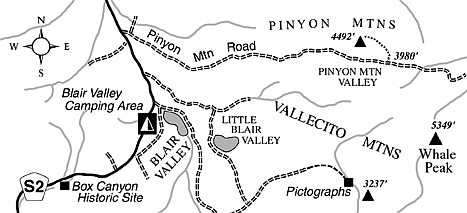 Facebook
Facebook
 X
X
 Instagram
Instagram
 TikTok
TikTok
 Youtube
Youtube
The late-winter midday sun gently simmers the lowest elevations of Anza-Borrego Desert State Park, yet it more coolly illuminates the 4000-foot plateau of Pinyon Mountain Valley, lying high in the park’s central mountain range — the Vallecito Mountains. Sixty-degree days and possibly sub-freezing, star-filled nights await adventurous car-campers who navigate their vehicles into this secluded bit of flatland. Two pinyon-pine-studded ridges flank the valley north and south, the southern of the two containing 5349-foot Whale Peak, a favorite destination among desert “peak baggers.” A far easier hike darts up the steep ridge to the north and ends at the 4492-foot high point of the Pinyon Mountains (a sub-range of the Vallecito Mountains).
To get to Pinyon Mountain Valley, you will certainly need a high-clearance SUV or truck. From Scissors Crossing (12 miles east of Julian on Highway 78), go southeast on Highway S-2. After about five miles, specifically at mile 21.4 according to the roadside mile markers, turn left on unpaved Pinyon Mountain Road. Stay right at the fork in 0.1 mile, and continue up a gentle incline on the eastward-trending, sandy road. A short stretch of protruding rocks is encountered about four miles up the road, which will likely block all but off-road-capable vehicles. At 5.7 miles, the road tops a watershed divide at 3980 feet elevation in the middle of a broad saddle named Pinyon Mountain Valley. Find a place to park anywhere in the saddle area.
The 4492-foot high point of the Pinyon Mountains swells just north of Pinyon Mountain Valley, and the two-mile (probably 1 1/2-hour) round-trip, cross-country hike to the summit is an ideal recreational pursuit during the earliest or the latest parts of the daylight period. The south-facing slopes you climb are almost bald, but scattered growths of pinyon pine and nolina (a yucca look-alike that is nicknamed “beargrass”) are found on the summit and on the north-facing slopes, where the sun’s drying effect is allayed.
From the top, Whale Peak swells across the southern horizon, blocking more distant views in that direction. Opposite, however, is a sweeping vista of the San Ysidro and Santa Rosa mountains, Borrego Valley, the Borrego Badlands, and the Salton Sea — the entire landscape colored by the blue shadows that are either advancing or retreating across the desert floor.
This article contains information about a publicly owned recreation or wilderness area. Trails and pathways are not necessarily marked. Conditions can change rapidly. Hikers should be properly equipped and have safety and navigational skills. The Reader and Jerry Schad assume no responsibility for any adverse experience.

Pinyon Mountain
Scramble to the high point of Anza-Borrego’s Pinyon Mountain for a dramatic view.
Distance from downtown San Diego: 82 miles
Hiking length: 2.0 miles round trip
Difficulty: Moderate

The late-winter midday sun gently simmers the lowest elevations of Anza-Borrego Desert State Park, yet it more coolly illuminates the 4000-foot plateau of Pinyon Mountain Valley, lying high in the park’s central mountain range — the Vallecito Mountains. Sixty-degree days and possibly sub-freezing, star-filled nights await adventurous car-campers who navigate their vehicles into this secluded bit of flatland. Two pinyon-pine-studded ridges flank the valley north and south, the southern of the two containing 5349-foot Whale Peak, a favorite destination among desert “peak baggers.” A far easier hike darts up the steep ridge to the north and ends at the 4492-foot high point of the Pinyon Mountains (a sub-range of the Vallecito Mountains).
To get to Pinyon Mountain Valley, you will certainly need a high-clearance SUV or truck. From Scissors Crossing (12 miles east of Julian on Highway 78), go southeast on Highway S-2. After about five miles, specifically at mile 21.4 according to the roadside mile markers, turn left on unpaved Pinyon Mountain Road. Stay right at the fork in 0.1 mile, and continue up a gentle incline on the eastward-trending, sandy road. A short stretch of protruding rocks is encountered about four miles up the road, which will likely block all but off-road-capable vehicles. At 5.7 miles, the road tops a watershed divide at 3980 feet elevation in the middle of a broad saddle named Pinyon Mountain Valley. Find a place to park anywhere in the saddle area.
The 4492-foot high point of the Pinyon Mountains swells just north of Pinyon Mountain Valley, and the two-mile (probably 1 1/2-hour) round-trip, cross-country hike to the summit is an ideal recreational pursuit during the earliest or the latest parts of the daylight period. The south-facing slopes you climb are almost bald, but scattered growths of pinyon pine and nolina (a yucca look-alike that is nicknamed “beargrass”) are found on the summit and on the north-facing slopes, where the sun’s drying effect is allayed.
From the top, Whale Peak swells across the southern horizon, blocking more distant views in that direction. Opposite, however, is a sweeping vista of the San Ysidro and Santa Rosa mountains, Borrego Valley, the Borrego Badlands, and the Salton Sea — the entire landscape colored by the blue shadows that are either advancing or retreating across the desert floor.
This article contains information about a publicly owned recreation or wilderness area. Trails and pathways are not necessarily marked. Conditions can change rapidly. Hikers should be properly equipped and have safety and navigational skills. The Reader and Jerry Schad assume no responsibility for any adverse experience.

Pinyon Mountain
Scramble to the high point of Anza-Borrego’s Pinyon Mountain for a dramatic view.
Distance from downtown San Diego: 82 miles
Hiking length: 2.0 miles round trip
Difficulty: Moderate